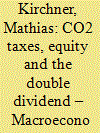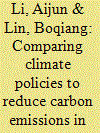| Srl | Item |
| 1 |
ID:
163553


|
|
|
|
|
| Summary/Abstract |
This paper investigates the impacts of CO2 tax schemes on CO2 emissions, equity and macroeconomic indicators in Austria with the macroeconomic model DYNK[AUT]. Our scenarios focus on non-ETS CO2 emissions and comprise different tax rates and revenue recycling options (lower labor taxes, lower VAT and lump sum payments). The short-term comparative scenario analysis indicates that CO2 taxes without recycling lead to significant CO2 emission reductions at moderate economic costs. Equity impacts on households depend on the indicator used but can be regressive without recycling. Most recycling schemes can achieve a double dividend, i.e. emission reductions and increases in GDP. Lump sum payments are less efficient than reducing the VAT or labor taxes. Equity impacts are progressive with lump sum payments, rather proportional with lower VAT and regressive with lower labor taxes. A combination of recycling schemes and/or a restriction of lump sum payments to lower income households can minimize the trade-off between equity and efficiency. Our simulations suggest that well-designed CO2 tax schemes could be a crucial and socially acceptable element within a comprehensive policy package to achieve GHG emission targets for non-ETS sectors in Austria.
|
|
|
|
|
|
|
|
|
|
|
|
|
|
|
|
| 2 |
ID:
124506


|
|
|
|
|
| Publication |
2013.
|
| Summary/Abstract |
Currently, China is the largest carbon emitter mainly due to growing consumption of fossil fuels. In 2009, the Chinese government committed itself to reducing domestic carbon emissions per unit of GDP by 40-45% by 2020 compared to 2005 levels. Therefore, it is a top priority for the Chinese government to adopt efficient policy instruments to reduce its carbon intensity. Against this background, this paper develops a general equilibrium model and seeks to provide empirical contributions by comparing the potential impacts of several different policy options to reduce China's carbon emissions. The main findings are as follows. Firstly, these climate policies would affect the structure of economy and contribute to carbon emissions reduction and carbon intensity reduction. Secondly, there would be significant differences in the economic and environmental effects among different climate policies and hence, the government would trade-off among different economic objectives to overcome any potential resistances. Thirdly, there would be considerable differences in the emissions effects of absolute and intensity-based carbon emissions controls, implying that the government might adopt different climate policies for absolute or intensity-based carbon emissions controls. Looking ahead, the government should trade-off among different objectives when designing climate reforms.
|
|
|
|
|
|
|
|
|
|
|
|
|
|
|
|